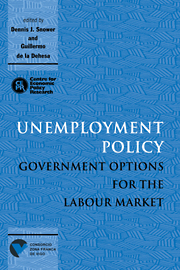Book contents
- Frontmatter
- Contents
- List of figures
- List of tables
- Preface
- Acknowledgements
- List of conference participants
- 1 Introduction
- PART ONE GENERAL POLICY ISSUES
- PART TWO DEMAND MANAGEMENT AND SUPPLY-SIDE POLICY
- PART THREE SUBSIDISING EMPLOYMENT AND TRAINING
- PART FOUR LABOUR MARKET REGULATIONS
- 12 An analysis of firing costs and their implications for unemployment policy
- Discussion
- Discussion
- 13 Labour market regulation and unemployment
- Discussion
- PART FIVE POLICY, JOB REALLOCATION AND THE UNEMPLOYMENT–PRODUCTIVITY RELATION
- PART SIX COMPARING UNEMPLOYMENT POLICIES
- Index
Discussion
Published online by Cambridge University Press: 07 September 2010
- Frontmatter
- Contents
- List of figures
- List of tables
- Preface
- Acknowledgements
- List of conference participants
- 1 Introduction
- PART ONE GENERAL POLICY ISSUES
- PART TWO DEMAND MANAGEMENT AND SUPPLY-SIDE POLICY
- PART THREE SUBSIDISING EMPLOYMENT AND TRAINING
- PART FOUR LABOUR MARKET REGULATIONS
- 12 An analysis of firing costs and their implications for unemployment policy
- Discussion
- Discussion
- 13 Labour market regulation and unemployment
- Discussion
- PART FIVE POLICY, JOB REALLOCATION AND THE UNEMPLOYMENT–PRODUCTIVITY RELATION
- PART SIX COMPARING UNEMPLOYMENT POLICIES
- Index
Summary
In Europe as a panacea for European unemployment, chapter 12 should be welcomed. In a very simple and pedagogical way, Alison Booth reminds us that once we depart from the standard, static, competitive analysis that usually underlies the calls for increased flexibility, there is room for bargained redundancy payments without negative effects on employment. The argument goes as follows. In more realistic environments in which agents have market power and there is uncertainty, risk-averse workers will prefer a contract with redundancy pay since it irons out fluctuations in employment across time. Likewise, risk-neutral firms, which benefit from long-term employment relationships, will be willing to bargain firing costs with the workers. The outcome of this model is that the wage corresponding to the level of ex post employment equals the opportunity cost of labour, namely, the bargaining surplus is maximised. The argument is clear-cut and I could not agree more. Indeed, although the author considers this result to be ‘striking’, it is not difficult to show that the argument is isomorphic to the standard one used in the ‘implicit contract’ theory, in the case where the firm is allowed to choose the wage of the attached worker both under employment and unemployment, so as to avoid ‘over-employment’ (see Akerlof and Mizayaki, 1980).
Let us start by clarifying why the result is not so ‘striking’. Using the notation of chapter 12 for period 2, consider a firm offering an implicit contract in terms of (n, wnwu) where wn and wu denote the wage while working and laid off, respectively.
- Type
- Chapter
- Information
- Unemployment PolicyGovernment Options for the Labour Market, pp. 388 - 392Publisher: Cambridge University PressPrint publication year: 1997



